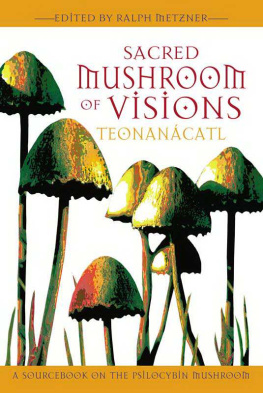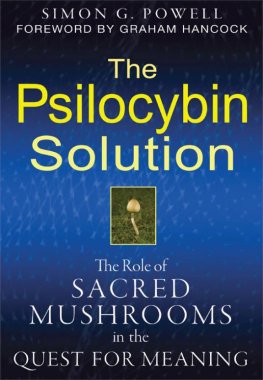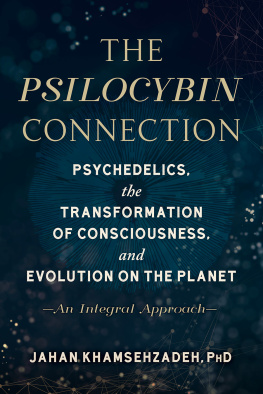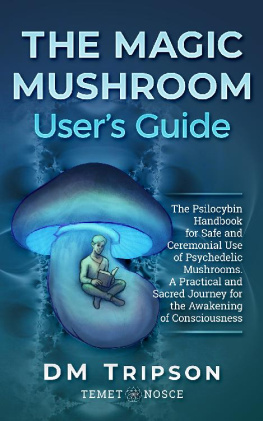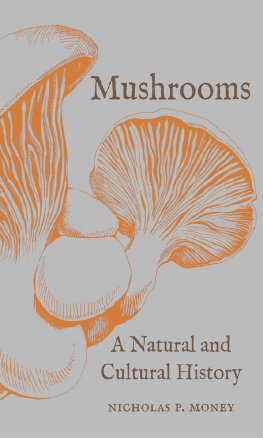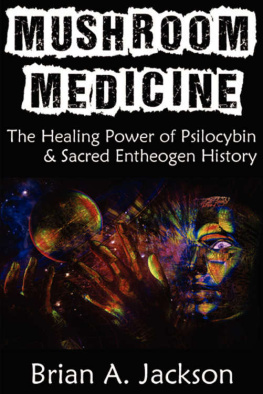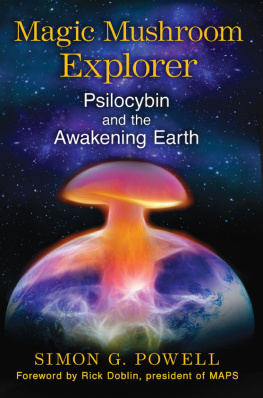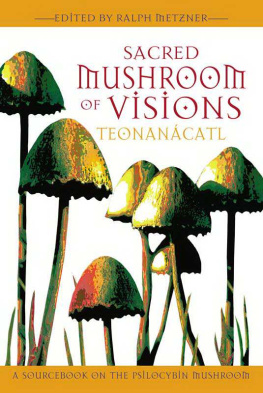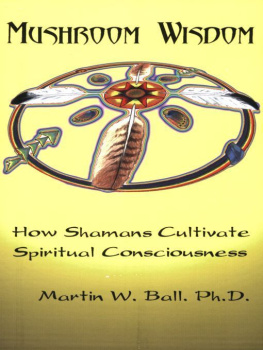
Edited by Ralph Metzner, Ph.D.
with Diane Conn Darling

Park Street Press
Rochester, Vermont
THIS BOOK IS DEDICATED TO
M ARA S ABINA (18941985), Mazatec Wise Woman and Healer who spoke the Holy Language of the nios santos and preserved their spiritual wisdom.
R OBERT G ORDON W ASSON (18981986), scholar, world traveler and ethnomycologist who rediscovered the teonancatl cult of the indigenous people of Mexico and brought the gifts of this ancient religion to the modern world.
A LBERT H OFMANN (who celebrated his ninety-ninth birthday in 2005), scientist, alchemist and nature mystic who found the Stone of the Wise, identified the crystal essencepsilocybinof the holy mushroom, and fathomed the secret of the Eleusinian Mysteries.
T IMOTHY L EARY (19201996), psychologist, visionary philosopher, and trickster, who ate the sacred mushroom and inspired a generation to go out of your mind and come to your senses.
T ERENCE M C K ENNA (19462000), scholar, bardic seer, emissary from the mushroom world, who mapped the hidden landscape of hyperspace, communed with alien intelligence, and showed the way to join the cosmic community.
A CKNOWLEDGMENTS
The editors acknowledge with gratitude
Visionary artist Robert Venosa, for permission to use his magnificent painting Shroomglow (oil, collection of Glenn Bailey) on the cover of the first edition of this book, published by Green Earth Foundation, 2004. See: www.venosa.com.
Elizabeth Gordon and the late Bob Wallace for financial support on the first edition.
Kathleen Harrison, for permission to use her drawings of the psilocybe life-cycle, and the Bee-Mushroom Goddess from the Tassili Plateau.
The information provided in this book is for educational, historical, and cultural interest only and should not be construed as a guide to or advocacy of the use or ingestion of the teonancatl mushrooms. The psilocybe mushrooms, wild or cultivated, as well as substances derived from them, are controlled substances under U.S. laws. In no way should the material in this book be taken to advocate, explicitly or by implication, the use of these mushrooms or any other illegal substance. Neither authors nor publisher assume any responsibility for physical, psychological, or social consequences resulting from the ingestion of these mushrooms or their derivatives.
C ONTENTS
R ALPH M ETZNER , P H .D.
J OHN W. A LLEN AND J AMES A RTHUR
P AUL S TAMETS
T HOMAS R IEDLINGER
D AVID E. P RESTI , P H .D., AND D AVID E. N ICHOLS , P H .D.
T ORSTEN P ASSIE , M.D.
D IANE C ONN D ARLING , R ICK D OBLIN , AND R ALPH M ETZNER
R ICK D OBLIN , P H .D.
T IMOTHY L EARY
R ALPH M ETZNER
L EILA C ASTLE
F REDERICK S WAIN
B RET B LOSSER
R AOUL A DAMSON
K ATE S.
E VAN P SILO
G ANESHA
C AT L.
A BRAHAM L.
J ASON S ERLE
M INDFIRE
L EOPOLD
P HIL O. C YBE
T HIRDPALISSY
D AVID S.
M ARK B RYAN
J ACK S ILVER
M ARK A. S CHROLL , P H .D.
K ARIN R IESE
M ARTIN G OODMAN
Introduction
V ISIONARY M USHROOMS OF THE A MERICAS

R ALPH M ETZNER , P H .D.
Teonancatl was the name given to one or more species of psilocybe mushrooms in the Nahuatl language of the Aztec people. From Conquest times onward, the name has been translated as gods flesh. The Spanish friars seized upon this to justify the equation of Nahua mushroom ceremonies to devil worship. By regarding it as a diabolical mockery of the consumption of the body of Christ in the Eucharistic communion rite, the friars felt justified in banning the religious practice of the Indians. However, in his 1980 book The Wondrous Mushroom, ethnomycologist R. Gordon Wasson, who rediscovered the shamanic ritual use of psilocybe mushrooms in contemporary Mexican Indian cultures, pointed out that teonancatl could also, and more correctly, be translated as wondrous mushroom, sacred mushroom, or even awesome mushrooms.
What is clear, both from the accounts of the Spanish chroniclers and from the accounts of modern anthropologists, is that these visioninducing mushrooms were (and are) revered by the Indians for providing deep spiritual insight and inspiration. The names given to the mushrooms by some of the Mexican Indian tribesMazatec, Mixtec, Zapotec, and othersconfirm the reverence and affection the mushrooms inspire: holy lords, little saints, children (los nios), dear little ones that spring forth (nti-xi-tho , Mazatec), little princes. The Aztecs also called them little flowers, although fungi do not bloom. For them flower was a metaphor, as it was for the Maya, for whom flowering dreams refers to ecstatic visions.
In 1957, Wasson published in LIFE magazine his account of a mushroom session with a Mazatec curandera in a remote mountain village in the state of Oaxaca. The psilocybe mushroom exploded into Western consciousness and during the transformative 1960s, thousands of hippies trekked to the mountains of Oaxaca, seeking consciousness-expanding mushroom experiences. This development was much to the dismay of Wasson and other conservative researchers, who felt that this kind of activity cheapened and desacralized the religious dimensions of the mushroom experience.
Wasson had become friends with Albert Hofmann, the brilliant research chemist of the Sandoz pharmaceutical company in Switzerland. About ten years earlier, in 1943, Hofmann had discovered the astounding mind-expanding effects of lysergic acid diethylamide (LSD), a compound derived from the ergot fungus that grows on rye and other grains. Upon obtaining samples of the Mexican mushroom from Wasson, Hofmann was able to identify and then synthesize the psychoactive ingredient, which he named psilocybin , after the psilocybe mushroom. Thus Western scientific and psychiatric research with psychedelic hallucinogens was linked with ancient Meso-American shamanic practices that used visionary mushrooms as well as plants.
After the initial wave of North American and European magic mushroom hunters had descended on the mountain villages of Mexico, reports started appearing that psilocybin-containing mushrooms were not limited to Mexico. In fact, they could be found in many parts of the world, including Hawaii, South America, Europe, and Southeast Asiaand were particularly widespread in the American Pacific Northwest coastal areas, due to the abundant rainfall. To date, several new species and varieties of psilocybin-containing mushrooms have been identified. The chapters by John Allen and Paul Stamets in this volume describe the worldwide distribution and ecology of these psychoactive mushrooms. More extensive and detailed information can be found in two books by Jonathan Ott (1976, 1978); in German mycologist Jochen Gartzs Magic Mushrooms Around the World (1996); and in Paul Stametss Psilocybin Mushrooms of the World (1996). Both of the latter two books are illustrated with full-color photographs, an essential feature for safe identification of mushrooms in the wild. None of the psilocybin-containing species of mushrooms outside of Mexico are known to have been associated with shamanic healing practices.
In addition to the increasing discovery and identification of wildgrowing psychoactive mushrooms, a major boost to free-lance personal explorations of visionary mushroom experiences occurred when relatively simple techniques of home cultivation of major species, especially Psilocybe (originally Stropharia) cubensis, were developed and published. One of the first was the cultivation guide written by the McKenna brothers, under the pseudonyms O. T. Oss and O. N. Oeiric (1976), which has sold over one hundred thousand copies. The spread of mushroom cultivation provided thousands, perhaps millions, of individuals in North America and elsewhere easy access to powerful tools for exploring the visionary dimensions and potentials of human consciousness. These tools and the experience they afforded have inspired the growth of a mushroom culture, including visual, literary, and musical arts as well as ritualistic dance forms, such as the Grateful Dead shroom events. Because of the controlled legal status of psilocybin mushrooms, cultivation methods will not, of course, be described in this book.
Next page
